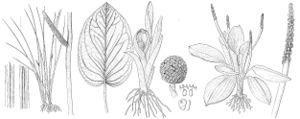Acorus
Sp. Pl. 1: 324. 1753; Gen. Pl. ed. 5; 151, 1754.
| Taxon | Illustrator ⠉ | |
|---|---|---|
 | Orontium aquaticum Acorus calamus Symplocarpus foetidus | John Myers John Myers John Myers |
Herbs, wetlands or rocky stream banks, when bruised or broken producing pleasant and distinctive aromatic odor. Leaves bright green; sheathing base 2-facial (proximal part of leaf); distal part of leaf 1-facial, flattened in median rather than transverse plane; prominent veins 1–6, parallel along length of leaf. Inflorescences solitary. Flowers: tepals light-brown; anthers yellow, introrse; ovariesy green. Fruits light-brown to reddish with darker streaks. Seeds embedded in mucilage. x = 12.
Distribution
Temperate Northern Hemisphere, tropical Asia at higher elevations, sporadically in Southern Hemisphere
Discussion
Considerable confusion exists in the taxonomic literature over the status of Acorus in North America. Whether Acorus is native or introduced, as well as the number of taxa in North America, has been debated for years. Evidence based on studies of morphology, essential oil chemistry, cytology, isozymes, and ethnobotany supports the existence of two species in North America—A. calamus, an introduced sterile triploid, and A. americanus, a native fertile diploid (J. G. Packer and G. S. Ringius 1984; S. A. Thompson 1995). Acorus americanus is not only morphologically distinct from triploid A. calamus but also from diploid and tetraploid A. calamus populations occurring in Asia (L. C. M. Röst 1979; S. A. Thompson 1995). Although the existence of two species of Acorus in North America was discussed by J. G. Packer and G. S. Ringius (1984) and A. americanus has been listed in several North American floras, this is the first flora that formally treats two species of Acorus in North America and provides a key to distinguish these two species.
Traditionally, the name Acorus calamus has been applied to all populations of Acorus in North America without regard for the biological species involved. Other authors (e.g., E. T. Browne and R. Athey 1992; K. A. Wilson 1960) have adopted A. americanus as the "correct" name for all Acorus in North America, including populations in regions where only A. calamus occurs or is the predominant species. The use of either name in the literature requires further study to determine which species is being cited.
The rhizomes of Acorus calamus contain an aromatic oil that has been used medicinally since ancient times and has been harvested commercially. Native Americans exploited Acorus as a medicine and for ceremonial uses. Although this plant is cited in the ethnographic and ethnobotanical literature as A. calamus, the distribution of the tribes reported to use Acorus corresponds to the range of the native species (S. A. Thompson 1995).
The combination of equitant, sword-shaped leaves plus an elongate inflorescence borne about midway on a sympodial leaf is not found in any other North American plant. Fresh material of Acorus is easily distinguished from other plants by the unique pleasant fragrance given off by rhizomes and leaves when broken. The bright green color of the leaves is also distinctive.
Species 3–6 (2 in the flora).
Selected References
Lower Taxa
Key
| 1 | Midvein prominently raised above leaf surface, other veins barely or not raised; mature fruits not produced, sterile triploid | Acorus calamus |
| 1 | Midvein plus 1–5 additional veins ± equally raised above leaf surface; mature fruits produced, fertile diploid. | Acorus americanus |